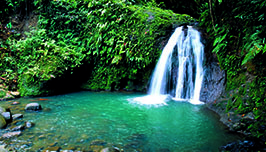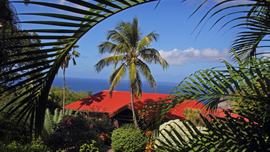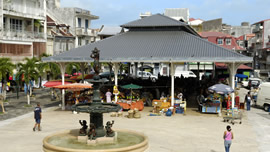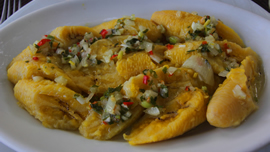
Diversity and traditions


WHERE TO DO
More information
WHERE TO STAY
More information
WHAT TO BRING
More informationFOODING - WHAT TO EAT?

CREOLE CUISINE
Classical and quintessential Créole dishes you will find on a menu
Starters
- Boudin (black pudding, sausage);
- Accras (cod or vegetable fritters);
- Crabes farcis (a spicy mixture of crab meat, bread crumbs, garlic and chives served in the shell);
- Féroce d’Avocat (well seasoned, mashed avocado mixed with codfish and manioc flour).
Main Courses:
- Court Bouillon de Vivaneau (Red Snapper Court Bouillon);
- Colombo de poulet, de porc ou de cabri (an aromatic chicken, pork or goat curry usually served with rice);
- Fricassée de Lambi (Queen Conch stew usually served with rice and red beans or yam, dasheen, breadfruit);
- Calalou (a thick and spicy soup made with spinach, okra, pork and land crab usually served with rice).
Sweets :
- Exotic Fruit abounds: pineapple, orange, banana, guava, mango, grapefruit,melon, watermelon, tamarind, acerola cherry,…
- Sorbet Coco, Flan au Coco (Coconut Ice cream, Coconut Flan);
- Tourment d’Amour, a local pastry filled with coconut, guava or banana jam.
And when hungry, for a quick bite « à la Créole », try our traditional “Bokit”, the local burger shaped like a chausson, fried like a doughnut, with a stuffing of chicken, cod fish, conch, cheese and ham. Simply Delicious! Bon Appétit!
MARKETS
Colourful, picturesque, bursting with flavours, jam packed with goods and frequented by a noisy crowd, they are to be found in every single town and borough. Real key places, they play a vital part in the life of the community.
Usually in the open air or under a large metallic structure, most markets are open daily, except on Sundays. And if you really want to feel the pulse of the islands, be there on a Saturday morning! Coming from the nearby villages and country farms, the vendors exhibit their merchandise “made in Guadeloupe” on large stalls or even on the ground: loads of fruit, vegetable, flowers, animals farm, fish, spices, plants, handicrafts …And if you missed the morning show, you can always catch up with the evening performance (once a week in certain villages like in Le Gosier or Saint-François).
For the real adventurous, on a hot sunny day, it’s the perfect place to drink fresh coconut water straight from the coconut! You can also sample a glass of freshly crushed sugar cane! Surprising … Isn’t it?
SPICES AND LOCAL FLAVOURS
The success of the Guadeloupe Islands’ cuisine is essentially based on the subtle usage of spices and condiments. Each of them has a proper part in the classical dishes of the Guadeloupe Gastronomy. Ginger, pepper, cloves, saffron, curcuma, cardamom, roucou, and paprika, bay leaves, star anise … Just to name a few!
BANANA
A volcanic soil and a hot and humid climate in southern Basse-Terre make up the perfect condition for the growing of banana. Apart from the “Cavendish” type commonly found in Europe, the Guadeloupe Islands also grow several savoury types such as the plantain banana and the “figue pomme”.
VANILLA
Vanilla, otherwise known as the “queen of spices”, grows mainly in the upland, shady regions of Basse-Terre. Although the production is done on a small scale, the vanilla business is run by a few enthusiasts like Vanibel who take great care of their plants in order to achieve top quality.
COFFEE
Very few people know that Guadeloupe still produces coffee of a prestigious high quality variety called the “Bourbon Pointu”.
Since its introduction on the islands by the French settlers (1721), the protected hillsides of the Leeward Coast of the Basse-Terre Island with its rich volcanic soils became the homeland of this new imported product.
After a promising start, the coffee production came gradually to an end after several cases of plant disease affecting the plantations. But since a few years, a new generation of farmers strive for the revival of the Guadeloupe Coffee. Today thanks to the united efforts of several planters and farmers, coffee plantations are gradually reappearing and their restored domains become more and more active and productive. They offer almost everything, tours of the domain, ateliers and talks about the various production procedures (the picking of the beans which is still done by hand, the de-pulping, the drying and the roasting) followed of course by a good hearty meal and a coffee-tasting session.
Three different species are grown in Guadeloupe: the Arabica, the Robusta and the Liberia. The Arabica brand is the most commonly appreciated.
MAIN ATTRACTIVE SITES TO VISIT
- Le Bouchu
97 119 Vieux-Habitants
Tél. : 0590 98 54 96
W : www.cafechaulet.com - La Grivelière – Maison du Café
Vallée de la Grande Rivière
7 119 Vieux- Habitants
Tél. : 0590 98 63 06 - Cousinière – Caféière – 97 119 Vieux-Habitants
Tél. : 0590 98 40 79
W : www.vanibel.com - 97 116 - Pointe-Noire
W : www.cafeierebeausejour.com
Musée du Café
Domaine de l’Habitation
Le Domaine de Vanibel
La Caféière Beauséjour
COCOA
One of the main valuable crops in colonial times: The precious bean reigns supreme on the Leeward Coast of the Basse-Terre Island in the XVIII and XIX centuries.
Ousted by the growing of Sugar Cane and Banana, and after several climatic disasters, the cocoa production was constantly decreasing when fifteen years ago a young and gifted farmer had the bright idea of reviving the Guadeloupean Chocolate by re introducing on the plantations the top quality “Criollo” Cocoa variety.
In Guadeloupe, Cocoa growing, has always been associated with Coffee because they grow in rich and volcanic soils in the same protected region, the hills and slopes of the Leeward Coast of the Basse-Terre Island.
Guadeloupeans have always enjoyed a cup of hot chocolate made from the real “baton Kako Péyi”, a 100% pure chocolate stick which can be found on the markets and at “La Maison du Cacao” located in Pointe-Noire.
Today, a new generation of “Artisans Chocolatiers” are at work offering to locals and visitors their delicious and exquisite creations made with this unique produce.
MAISON DU CACAO
Grande Plaine – 97116 Pointe-Noire
Tél. : 0590 98 25 23
W : www.maisonducacao.fr
SUGAR CANE
A long time ago, nearly all of the Guadeloupe hinterland was occupied by sugar cane plantations. Gradually other challenging crops were introduced on the islands. Nevertheless, in spite of the declining of the sugar production and the closing of a number of mills, sugarcane is still an important crop to day.
Two sugar factories are still operating. With a golden colour, a thick grainy consistency, this product made in Guadeloupe gives a distinctive aroma to any recipe or culinary preparation.
RUM
The Guadeloupe Islands still boasts a major sugar cane industry. For Guadeloupeans (and many visitors alike!) Rum is Guadeloupe’s National drink!
Rum comes from the Sugar Cane. At harvest time, the cane is cut by hand on most of the sugar cane plantations then brought to the distilleries. There, it is crushed in mills to extract the juice. Once it has been filtered, this juice is taken to be fermented in large vats where it gradually turns into alcohol before being distilled. The final product or “Rhum Blanc” (50 to 55 proof) is aged in barrels for at least three years.
Rhum Blanc (White Rum) ou Rhum Vieux (Aged Rum), a bottle of rum is always at hand! The traditional tipple is called “Ti Punch”! It is made usually with White rum, sugar cane and served with a slice of lime.
There are 9 rum distilleries on the Guadeloupe Islands. Some of them have Rum tasting tours. All of the distilleries have gifts shops and Rum is definitely one of the best gifts to bring back from Guadeloupe.
Rum is commonly used for the preparation of cocktails (Planteur), (Punchs aux Fruits: Punch à l’ Ananas, Punch Passion, Punch Coco …) and Liqueurs (Shrubb).
Ti Punch is the local drink made of rum, sugar, served with a slice of lime. Guadeloupean rum is commonly used as an ingredient in the preparation of most exotic cocktails or the traditional “flambée” banana.
LA FETE DES CUISINIERES - THE COOKS FESTIVAL
For almost a century, this colourful event held in early August has taken place every year in celebration of Saint Laurent, the patron of cooks. Wearing their traditional colourful dresses, headscarves made of madras and their very best gold jewellery, some 250 cooks and chefs from all over Guadeloupe join together in the St-Peter and St-Paul’s Basilica to pray and sing praises. When leaving the church, they parade through the city of Pointe-à-Pitre before the traditional festive banquet with creole food, drinks, songs and dances galore!
Tel: 00590 590 84 77 68
00590 690 74 43 49
00590 690 74 43 50
